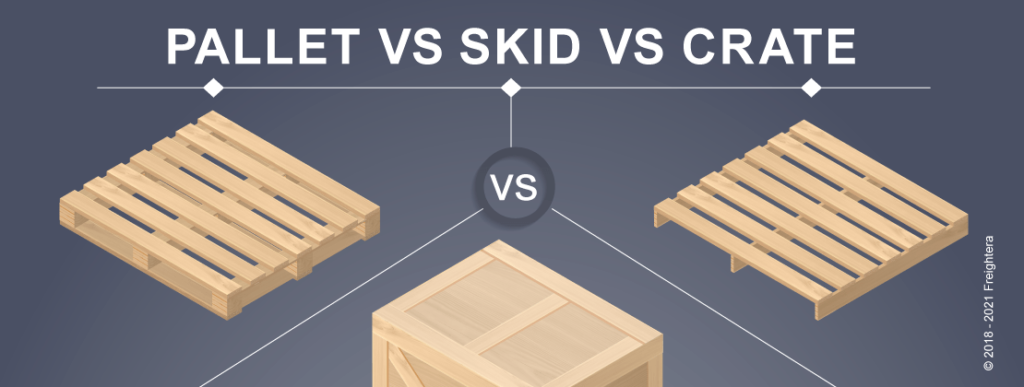What are the differences between pallet, skid, and crate?

In the world of freight shipping, the terms “pallet,” “skid,” and “crate” are frequently used to describe various packaging and shipping methods. Each plays a vital role in cargo movement, providing support and protection to the material being shipped. In this essay, we will explore the differences between these three crucial components and their significance in logistics.
What is a pallet?
A pallet is a required element in the world of freight shipping. It is a flat, generally wooden platform designed to facilitate the conveyance of goods. The pallet is essential for boosting the handling, storage, and movement of products in warehouses and across the logistics network.
Pallets are available in various dimensions and configurations, the most common being the standard 48×40 inches (1200х1000 millimeters), though other dimensions exist to accommodate specific cargo requirements. They are characterized by their bottom deck, the upper surface (top tier), and multiple stringer or block supports designed to accommodate the tines of a forklift or pallet jack’s prongs, making it easy to move and ship the items.
The use of pallet is especially prevalent in LTL (Less-Than-Truckload) shipments and provides efficient stacking and organization of goods in a warehouse or on a truck.
What is a skid?
A skid, like a pallet, is another form of cargo stowage, but it differs in some fundamental ways. A skid is a solitary floor loading platform constructed from timber, plastic, or metallic materials. Unlike a pallet, it lacks multiple bottom deck boards and support structures. Instead, a skid usually consists of a single solid deck with no spaces in between.
Skid is generally used when commodities need minimal elevation and can be directly placed on the floor of a warehouse or a vehicle. It is more versatile than a pallet, as it does not accommodate forklift tines, making them less suitable for situations requiring frequent movement and stacking of merchandise. A skid is typically employed for weighty loads that need extra support and stability.
What is a crate?
A crate is a distinct form of packaging and protection for cargo during transfer. It is a solid, enclosed box made from wood, metal, or plastic designed to protect fragile, high-value, or irregularly shaped items. In contrast to pallet and skid, crate completely enclose the goods, shielding them from external factors such as dust, moisture, or physical damage.
A crate is commonly used when the items are susceptible to damage or need extra security. These sturdy various container sizes and configurations are custom-built to fit the specific dimensions and needs of the cargo. The crate is an ideal choice for items such as machinery, artwork, or delicate equipment, where protection is paramount.

Conclusion
In freight shipping, Comprehending the distinctions between pallet, skid, and crate is critical for selecting the most suitable packaging and support method for your specific cargo. The pallet is versatile and well-suited for organizing and moving products efficiently. Skid offer added support for heavy loads but lack the flexibility of pallet. Crate, on the other hand, provide maximum protection for delicate or valuable items. Each of these options has its unique advantages and should be chosen based on the nature of the items, ensuring safe and efficient cargo delivery in the supply chain.
If you are still trying to decide which type of cargo fixing to choose – contact us for help. Send a request, and our manager will reach out to you.





